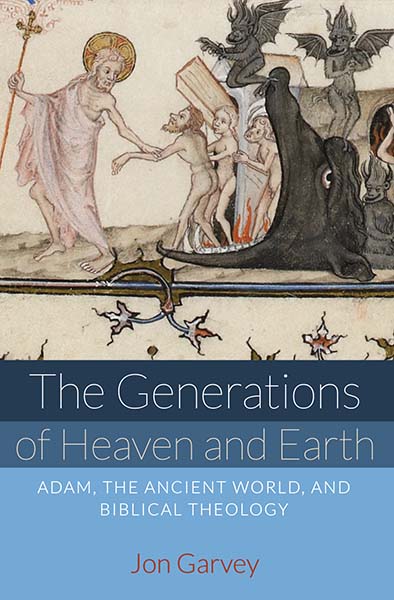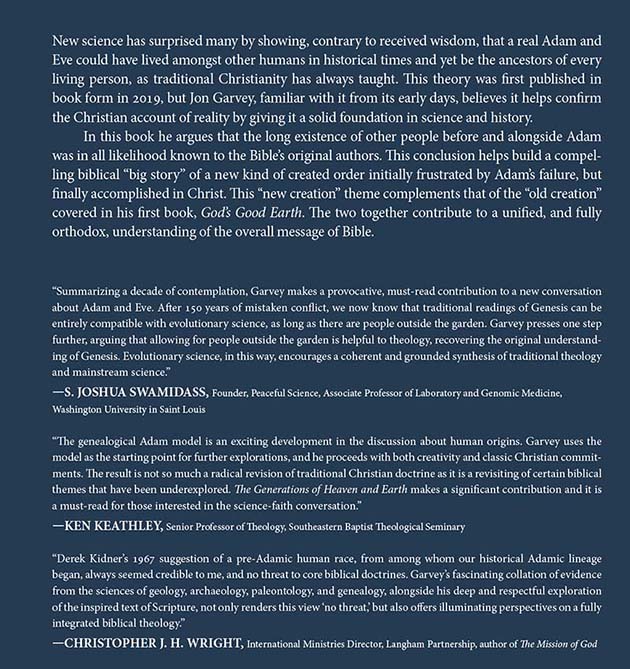…by looking at the cover
But you can at least try. The publisher sent me the proposed cover design for my forthcoming book before the weekend, which delighted me as it matches exactly what I had in mind (so it’s entirely my fault if it’s rubbish!).

The image is from a 14th century French “Book of Hours,” and its subject is “the harrowing of hell.” This was quite a common mediaeval subject (and this treatment is pretty close to the usual iconographic convention). It represents the risen, victorious, Christ releasing the captive souls from the power of sin and death, beginning with Adam and Eve themselves.
I chose it because it ties the new creation in Christ directly to the Eden account, and that direct connection is the major theme of the book (via the Genealogical Adam paradigm that Josh Swamidass’s book has since December introduced to the world at large).
The image also, incidentally, includes the theme of the defeat of Satan (to me represented by the mouth of hell as well as by the rather cute demons – it looks as though Satan’s mouth is jammed open by the cross, which is a pretty neat idea some evangelistic scheme ought to adopt). The overturning of the serpent’s scheme is another neglected theme of the biblical meta-narrative that I try to rehabilitate in the book.
Those who’ve read my God’s Good Earth will notice the uniformity of the cover design, and that’s deliberate: I see the books as a pair, God’s Good Earth being about the first, natural creation (and hence green!) and Generations being about the new, spiritual creation (and hence heavenly blue). All praise to Cascade’s Shannon Carter for getting it in one.
While I’m here, and since I’ve posted it on Peaceful Science at Joshua’s request, here is the endorsement section on the back cover:

I’m especially pleased by the last endorsement, by Chris Wright. That’s firstly because he’s a major international OT scholar (who not only shares my view of the OT as part of God’s single plan for the world, the “Missio Dei,” but is the go-to guy on that perennial talking point, the ethical excellence of the Mosaic Law in its historical context). Secondly, he is a Brit, albeit Northern Irish, which opens up the UK academic community to the book in a significant way.
You’ll note that he links his comments to the late great Derek Kidner, whose Genesis commentary was the first academic Christian book I bought, in 1971, and who was actually my neighbour at Tyndale House in Cambridge, the Evangelical research library where he was the warden, and where Wright studied a little later.
C. S. Lewis had speculated informally on the possibility of an Adam and Eve arising amongst pre existing “hominids,” but Kidner, in his 1967 commentary, was amongst the first conservative Evangelicals to propose such an idea seriously as an area for research, and to maintain that it could be held consistently with traditional teaching.
But both Lewis and Kidner stumbled over the problem of the universal descent from Adam taught by both the New Testament and Jewish sources, which seemed to be contradicted by science. It is only now, in the Genealogical Adam and Eve paradigm, that Kidner’s proposal comes of age, half a century later. Everything comes to those who wait patiently on the Lord…
One of the Amazon reviewers of Josh’s Genealogical Adam and Eve, Cheol Kwong, says:
The book becomes less focused when Dr. Swamidass moves into the theological portion…
He adds that this is consistent with Swamidass’s ultimate end for the book:
His overall point here is that this new understanding of the Genealogical Adam and Eve opens up a lot of space theologically: of course a single interpretation is not going to be singularly compelling. There are now many, many interpretations of Genesis that work quite well with the scientific accounts, including some quite literal ones, and Christians are now free to explore this much larger space in our search for the right interpretations.
That’s really how my book differs from Josh’s (and of course, to a large extent we hatched the plan together, so it isn’t fortuitous). Mine is the first attempt to apply the GAE paradigm to a specific theological framework, and in particular to a comprehensive biblical theology set in real history. The aim, whether successful or not, is to unwrap a unified Bible narrative, and to set that narrative in the real history of the world.
Naturally, as an author I believe my approach to be definitive, final and perfect… (<irony>). But although I hope it will answer major questions for both ordinary folks and biblical scholars, my larger aim is to demonstrate just one way in which the versatile GAE paradigm can be used. In other words, apart from any specific conclusions, it shows how the tool can be used.
All I need now is a publication date, and for you gentle readers to buy it, read it, and (ideally) review it for others’ benefit. </plug>.

